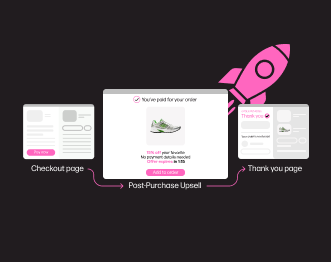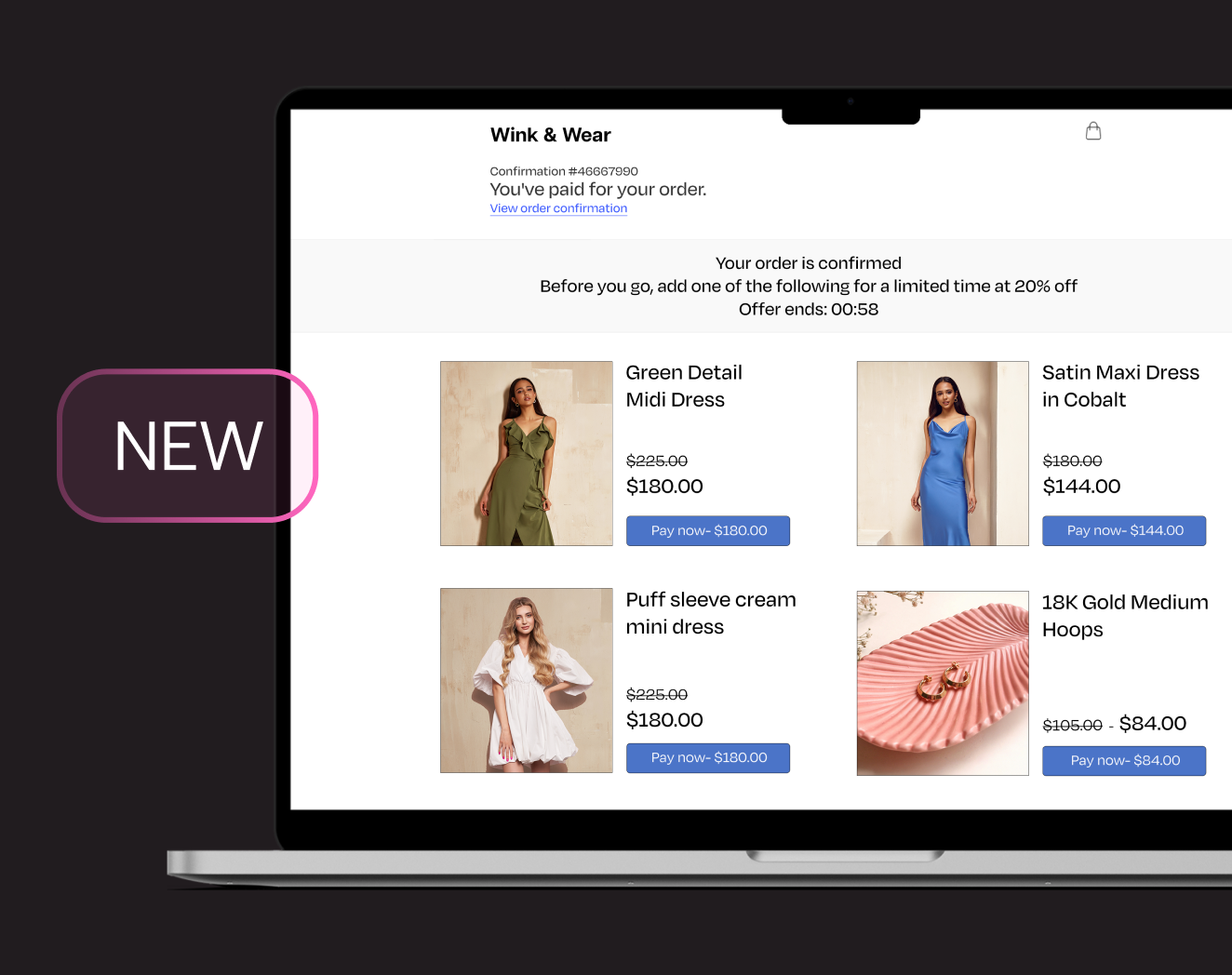Ecommerce Merchandising: Best practices to drive conversions
What is ecommerce merchandising?
Imagine walking into a well-designed retail shop. The products are thoughtfully displayed, the atmosphere is inviting, and everything seems to guide you toward making a purchase. Ecommerce merchandising does the same thing, but in a digital space.
At its core, it’s about creating a seamless shopping experience that connects the right products with the right customers. This involves everything from how products are organized on a website, to the images and descriptions used, to the personalized recommendations you see as you browse.
Effective ecommerce merchandising uses customer data and design to understand what customers want, then crafts an experience that makes it easy (and tempting) for them to convert.
How can ecommerce merchandising strategies improve online shopping?
Online retailers can use ecommerce merchandising to significantly enhance online shopping by making the experience more personalized, engaging, and efficient for customers.
Strong ecommerce merchandising strategies optimize every touchpoint in the customer journey: From the landing experience, to what they see when browsing category pages, to the recommendations they see across the site when looking at PDPs, to the products recommended once they add an item to their carts.
Each area should seamlessly guide shoppers toward discovering relevant products, enhancing their experience, and increasing conversions across your entire site.
Consistency and strategy are key.
Personalized ecommerce merchandising
Personalization is a game-changer in ecommerce merchandising, transforming how customers experience online shopping.
In fact, 70% of consumers say it’s important for brands to create personalized experiences and 72% say they’re more likely to purchase from a brand if it consistently provides them with one.
By analyzing behavior, preferences, and purchase history, online stores can showcase products that resonate with each shopper. This could mean suggesting complementary items, highlighting products that match their past purchases, or tailoring the shopping experience to reflect individual style or brand affinities.
Imagine your product sorting automatically updating to display exactly what a shopper wants to see—like guiding someone to the perfect aisle in a physical store. Personalized merchandising not only makes shopping easier but also enhances customer satisfaction by presenting them with products that truly align with their needs and tastes.
AI and automated merchandising
Ecommerce sites can use AI to quickly analyze vast amounts of data to predict what customers are looking for in real-time. They can automatically adjust product recommendations, sort items by relevance, and even tailor the website’s layout to each individual shopper. For example, if someone frequently buys sports gear, they might see more of those items highlighted on their homepage.
Automation also helps streamline operations behind the scenes. Automated merchandising can update inventory displays, adjust pricing, or run promotions based on real-time data—ensuring the most relevant products are always front and center. This not only enhances the customer experience but also enables businesses to respond swiftly to trends and customer needs without relying on manual intervention.
In essence, ecommerce merchandising, powered by AI and automation, transforms online shopping from a static experience into a dynamic, personalized journey. This has paved the way for online brands to develop much more sophisticated merchandising strategies. For example, for our client, Casio, “Using Nosto for category merchandising enables the team to work smarter, avoiding the need to make constant manual changes, freeing up their time for other activities” according to Monique Green, Ecommerce Manager.
Essential ecommerce merchandising strategies
Merchandising has evolved into a critical component of creating a relevant and personalized shopping experience for online customers—which today, is an expectation. A staggering 71% of consumers now anticipate personalized interactions when they shop, and 76% actually feel let down when brands don’t deliver on this front.
But here’s the thing: there’s no one-size-fits-all approach to ecommerce merchandising. Every brand has its unique style and business objectives, which means their merchandising strategies are just as unique.
Below are some common merchandising strategies that brands use to meet their goals.
Cross-selling and upselling techniques
Cross-selling and upselling have become cornerstone strategies in ecommerce. They not only boost revenue but also enhance the shopping experience by offering customers more of what they need—or didn’t know they needed.
Cross-selling is all about suggesting complementary products that enhance or complete the purchase. For example, if a customer is buying a smartphone, recommending a protective case, a screen protector, or a pair of wireless earbuds is a natural fit. This strategy is effective because it adds value to the original purchase, making the customer’s life easier while increasing overall sales.
Upselling takes a slightly different approach by encouraging customers to upgrade to a higher-end version of the product they’re considering. Think of it as guiding them toward a more premium option with additional features, better quality, or added benefits. For instance, if a shopper is looking at a standard laptop, suggesting a model with more storage, a faster processor, or an extended warranty can help them see the value in spending a bit more.
Dynamic bundles enable ecommerce stores to create personalized product packages. Merchants can use these to mix and match items based on shoppers’ preferences and what products complement each other, often offering them at a discounted price. For example, if a customer has added a face wash to their cart, a brand might offer a moisturizer and a serum to make a complete skincare set.
These techniques are essential for several reasons. First, they cater to the customer’s needs by offering relevant, thoughtful suggestions. Second, they can significantly increase the average order value, boosting the brand’s bottom line. When executed well, cross-selling and upselling feel less like a sales pitch and more like personalized advice—helping customers make informed decisions while driving business success.
Merchandising during sales periods
Sales periods are golden opportunities for ecommerce brands to drive traffic, clear out inventory, and bring in new customers. To truly capitalize on these moments, strategic merchandising is essential. The goal is to create an atmosphere of urgency and excitement while making it effortless for customers to discover the best deals.
Take Black Friday Cyber Monday (BFCM) as an example. During this busy period, your online store should prominently feature discounted products, ensuring they’re easy to find and buy. At the same time, it’s crucial to demote or remove out-of-stock items to remove friction from shopping experience and keep customers focused available items. To take your strategy a step further, focus on key areas like product listing pages (PLPs) and search results, where customers are actively hunting for bargains.
Then, use merchandising to help with inventory management. Promote products with high inventory to help with turning over stubborn products. The right merchandising strategy can help increase sales during sales periods.
Consider curating shoppable landing pages dedicated to sale items, making it easy for shoppers to find exactly what they’re looking for. You can organize these pages by price point, like $10 and below, or by specific categories, creating a one-stop shop that highlights your best deals and keeps customers engaged throughout the sale.
Merchandising product recommendations
Product recommendations are the digital equivalent of a helpful in-store associate who knows exactly what to suggest based on your needs. In ecommerce, these recommendations are often powered by sophisticated algorithms that analyze data from across the site to present the most relevant products to each shopper.
Several types of product recommendations can be highly effective. For instance, ‘Customers who bought this also bought…’-type suggestions help introduce shoppers to items that complement their current purchase. ‘You might also like…’ recommendations offer alternative products that align with a shopper’s tastes or past behavior. And ‘Frequently bought together’ options bundle related products, making it easier for customers to complete a purchase in one go.
These personalized product recommendations don’t just enhance the shopping experience but significantly increase average order value and customer satisfaction by making the journey more intuitive and personalized.
Visual merchandising
In the world of ecommerce, where shoppers can’t touch or try products before buying, visual merchandising plays a crucial role in capturing attention and driving sales. It’s about creating a visually appealing online store that showcases products in their best light.
High-quality images are essential, but choosing the right type of imagery can make all the difference. Flat lay shots provide a clean, detailed view of products, while on-model images offer context and help shoppers visualize how an item might look in real life.
To resonate with a diverse audience, consider using on-model images that represent a wide range of people, from body types to ethnicities. User-generated content (UGC) from social media can be incredibly valuable in enabling this, offering authentic, relatable visuals that build trust and engage customers. In fact, 87% of marketers think it’s a more authentic way to ensure diversity.
Strategically placed banners, color schemes, and even the layout of product pages can guide the shopper’s eye to key items, making it easier for them to find what they want. When done effectively, visual merchandising boosts sales and strengthens the brand’s image, creating an online shopping environment that’s as inviting as a brick-and-mortar store.
Optimizing for mobile ecommerce
With more people shopping on their smartphones than ever before, optimizing for mobile ecommerce is a necessity Mobile shoppers expect a seamless, fast, and intuitive experience that allows them to browse, compare, and purchase products with ease, no matter where they are.
Even if you’ve invested in a mobile app, optimizing your mobile site is crucial to providing an optimal shopping experience. Ensure that you’re delivering consistent experiences no matter where customers choose to shop, be it on a laptop, mobile, or app.
This starts with a responsive design that adapts perfectly to different screen sizes, ensuring that images are clear, text is legible, and navigation is straightforward. But it doesn’t stop there. Simplified checkout processes, mobile-friendly payment options, and fast-loading pages are all crucial to keeping mobile shoppers engaged.
Leveraging reviews and returns data
Incorporating reviews, ratings, and returns data into your merchandising strategy can be a game-changer for ecommerce brands. By strategically promoting products with high customer satisfaction and demoting those with frequent returns, you can fine-tune your product display to not only drive sales but also reduce return rates.
For example, brands can:
- Promote items with a star rating above a certain threshold and a minimum number of positive reviews.
- Demote products that consistently receive lower ratings or have a limited number of reviews.
- Promote items with a low return rate, signaling quality and customer satisfaction.
- Demote products with a high return rate, reducing the chances of customer disappointment.
This approach ensures that the products most likely to delight online shoppers are front and center, while those that are less successful are moved to the background. By giving more visibility to well-reviewed, low-return items, you increase the likelihood that shoppers will find and purchase products that others have loved—leading to fewer returns and higher customer satisfaction.
Conclusion
In today’s competitive online landscape, ecommerce merchandising isn’t just a nice-to-have—it’s essential for driving conversions and creating memorable shopping experiences. By leveraging strategies like personalization, AI-driven automation, strategic product recommendations, and optimized visual merchandising, you can guide your customers through a seamless, satisfying journey that keeps them coming back.
Whether you’re optimizing for mobile or using reviews and returns data to fine-tune your approach, the key is to continually adapt and refine your merchandising tactics to meet evolving customer expectations. With the right strategies in place, your online store can exceed the expectations of today’s savvy shoppers, driving both satisfaction and sales.




